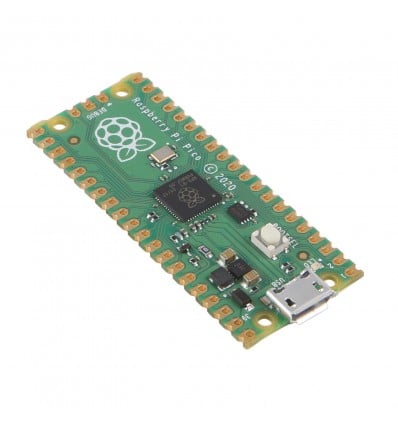International shipping Secure payment
No products
Prices are tax included
Product successfully added to your shopping cart
There are 0 items in your cart. There is 1 item in your cart.
The Raspberry Pi Pico is the Pi Foundation’s first foray into MCU, bringing a range of awesome features, extreme power-efficiency & great versatility.
5+ In Stock Items
Free shipping on orders over R1250 - courier delivery and within South Africa
The Raspberry Pi Foundation is quite a famous brand in the world of Electronics, bringing low-cost computing to the masses with an impressively wide range of Micro-Computers, equipped with everything that a Maker could need to get a fully functioning project up and running, from prototype to final design in a quick, efficiency and relatively easy way. However, there are oftentimes that we, as electronics Makers, don’t need so much power at our disposal, and that’s why Microcontrollers like Arduino Boards are typically more popular in the Maker scene, bringing just the right amount of power – no more, no less, to cater to small to intermediate projects that add fun, functionality or convenience to our lives. This is why we’re so excited that The Raspberry Pi Foundation has finally made a more focused approach to microcontrollers, with the Raspberry Pi Pico RP2040 Microcontroller being the first MCU that The Pi Foundation has brought to the market.
So What Makes the Raspberry Pi Pico Special?
For a brand that has previously focused solely on Micro-Computers, comprised of all the things you would need to behave as a full-fledged computer, it’s actually pleasantly surprising how nice the Raspberry Pi Pico is, and despite not being a part of their core focus, certainly does have a great place in the market, and in the workshop of any and all electronics and coding enthusiasts. It is quite similar in power and functionality to the reasonably new STM32 Black Pill Development Board, but in the classic Raspberry Pi style, it supports MicroPython and CircuitPython straight out of the box. This is complemented by the fact that Arduino have already announced that they will eagerly support the architecture with the Arduino IDE too, and this makes it one of the easiest board to use regardless of what kinds of microcontrollers you’re accustomed to already.
In terms of the key features that we Makers love most, the Pi Pico has built-in USB HID support, which makes it a great MCU to use for peripheral devices like custom computer mouses or macro keyboards, a 125MHz Dual-Core Crotex M0+ Processor with PIO co-processor for running complex and projects that need power and speed, an impressive 26 Multi-Function GPIO pins for interfacing with Modules and components, PWM Support on 16 different pins and three 12bit ADC capable pins for complex input/output applications, USB1.1 Host/Device with PHY support to make interfacing easy as Pi, and dual interfaces for UART, SPI and I2C to ensure that the Pico can communicate with an exceptionally wide range of protocols. All of this is complemented with an insanely low power consumption rate, supporting anywhere between 1.8V to 5.5V DC thanks to the built-in regulator, and operating on as low as 18mA for extreme power-efficiency.
While the Raspberry Pi Pico is far more similar to an Arduino than it is to a Raspberry Pi Board, the unique nuances of it also differentiate it from many other Microcontrollers that are available to Makers. And while it may not quite have the same speed as ESP32 or the same level of interfacing than the STM32 Black Pill, the unique blend that it does offer makes it an incredible choice in terms of both functionality and cost-effectiveness. So if you’re a fan of Raspberry Pi but hate the fact that Raspberry Pi Boards are very expensive to use for basic and simple projects, or if you’re a microcontroller fan who’s looking for a fresh new board to sink your teeth into and test the capabilities of, the Raspberry Pi Pico is an excellent choice for all kinds of awesome applications.
Raspberry Pi Pico RP2040 Microcontroller - Technical Specifications: |
|
|
– 2 x Cortex-M0+ |
|
– PIO |
|
– 1.8V to 5.5V DC |
|
– 18mA |
|
– 125MHz |
|
– External / 2MB |
|
– 264kB |
|
– 30 (26 Digital | 3 Analog | 1 Analog GND) |
|
– 3 x 12bit (GP26 | GP27 | GP28) |
|
– 16 Pins (GP0 to GP22 | GP26 to GP28) |
|
– Micro USB |
|
– 1.1 Host/Device with PHY |
|
– 2 x SPI – 2 x UART – 2 x I2C |
|
– SWD |
|
– -20° to +70°C |
|
– 3g |
|
– 21 x 51mm |
Additional Resources:
- If you want to find out more about the Raspberry Pi Pico, with all of the key features, pin mapping and other documentation that you might need as a Maker, be sure to browse through the official Raspberry Pi Pico Getting Started Page.
- Next up, for a more use-case focused review and explanation of the Raspberry Pi Pico, check out this Raspberry Pi Pico: Tutorials, Pinout, What You Need to Know article on Tom’s Hardware, which covers all of the juicy details that we Makers love to know about, as well as some basic instructions and help on getting started with your fresh new Pi Microcontroller.
- To get a better feel of what you might experience when getting you Pi Pico and setting it all up to use, take a look at this Raspberry Pi Pico - Review and Getting Started from Gary Explains, which covers the key features and visually demonstrates the steps you will need to take to get running with your Pi Pico.
Finally, if you’re still wondering how the Pi Pico might compare to other similar boards like the ESP32, ESP32-S2 and STM32 Black Pill, the following video by Andreas Spiess, “The Guy with the Swedish Accent” does an excellent job at covering all of the differences between these boards, and when you might want to choose a Pi Pico over an alternative option:
No customer reviews for the moment.
The primary aim of The Raspberry Pi Foundation is to enable people from all walks of life to understand, learn and develop our digital world with ideas that actually matter to them. Their single-board computers are designed with an open-source style, while being both easy to use and versatile. This allows people to build their own systems to cater to unique problems within their environment, while allowing them to share with and learn from others who are building similar types of systems – growing and developing the open-source movement in every step of the way.
The Raspberry Pi Foundation also takes their initiative a step further by building accessories like cameras, control interfaces and other products that can be seamlessly integrated into projects, made with high quality components but without the unnecessary frills that many brands choose to add on for “extra value”. This “no frills” approach makes their products more affordable while catering to consumers throughout the world, regardless of their financial condition. In doing so, people in almost any situation can use these products to improve their lives, better the world around them, and help develop both their local communities, as well as online communities of Makers.
Finally, like the cherry (or perhaps raspberry) on top of an already-great Sundae, The Raspberry Pi Foundation utilises the profits that they make to sponsor and host outreach and education efforts, with the intent to help people by making computing and digital development more accessible. They train educators and offer free resources online for people to learn from, giving consumers the power to change the world around them, and ultimately do their small part in developing the ever-expanding digital world too.






